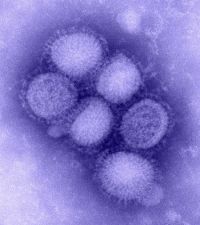In 2009, the virus H1N1 affected Americans. This led Americans to believe they were in great danger, becoming more aware of how to protect themselves against this virus.
The H1N1 flu, commonly known as “swine” flu, has hit America hard. According to the Centers for Disease Control and Prevention (CDC) website, during the months from April 2009 until January 16, 2010. there have been a total of 11,690 deaths and 257,000 hospitalizations due to this flu.
Overall, known cases, hospitalizations and deaths caused from the H1N1 virus in the United States has totaled 57 million cases. Of those, 19 million were people 17 years old and younger, 33 million were 18 to 64, and 5 million were 65 or older, reports the CDC.
According to Dr. Jeffrey Taubenberger from the National Institute of Allergy and Infectious Diseases, the patterns of damage to the airway in the swine flu autopsies closely matched those from earlier 1918 and 1957 flu pandemics.
According to the CDC, the flu attacks the entire respiratory system, but mainly targets three major organs: the lungs, bronchial tubes, and trachea.
The World Health Organization (WHO) has provided information based on autopsy reports that in all cases the upper respiratory tract is inflamed and severely damaged. In over half of the H1N1 cases, the lower respiratory tract is also inflamed, or damaged. In over two-thirds of the cases there was also damage in the air sacs in the lungs.
Healthy, young adults are at risk for contracting the H1N1 virus, and protecting yourself is very important. “Getting vaccinated is the best way to protect yourself and your family against the H1N1 flu virus,” said Kathleen Sebelius, the head of the U. S. Department of Health and Human Services on September 11, 2009. “Fighting the flu is a shared responsibility, and it is up to all of us to help prevent the spread of the flu in your community.”
On their website, the staff of the Mayo Clinic published that there are many more things you can do to protect yourself from the H1N1 virus. These include washing your hands often, using tissue when you sneeze or cough, sneezing or coughing against your inner arm or sleeve, not touching your eyes or nose without washing your hands first, staying away from people who are sick, limiting contact with others if you are sick, staying home if you are sick, and trying to keep healthy by eating and exercise.
In a June 11, 2009 news conference, Dr. Margaret Chan, Director General of the WHO, said that the virus is now stoppable. She mentioned that symptoms of the H1N1 virus are different in adults and children. Adults suffer from difficulty breathing or shortness of breath, pain or pressure in the chest or abdomen, sudden dizziness, confusion, severe or persistent vomiting, and/or flu-like symptoms which improve, but then return with fever and worse cough. Children, on the other hand, experience fast breathing or trouble breathing, bluish or gray skin color, not drinking enough fluids, severe or persistent vomiting, not waking up or feeling lethargic, being so irritable that the child does not want to be held, and flu-like symptoms that improve, then return with a fever and worse cough.













